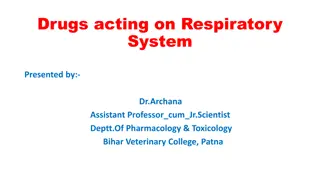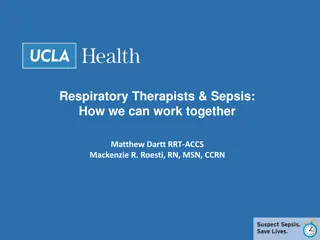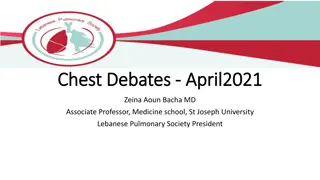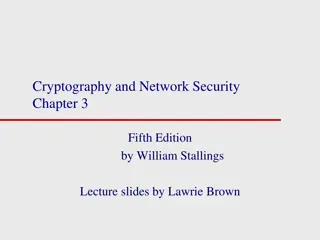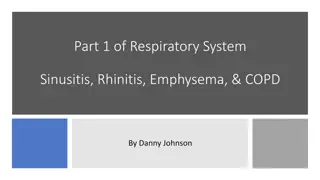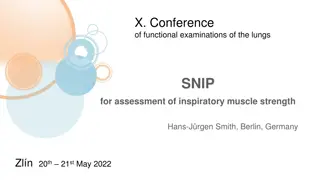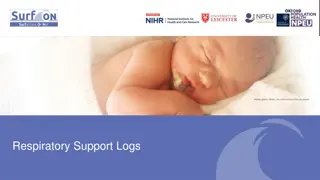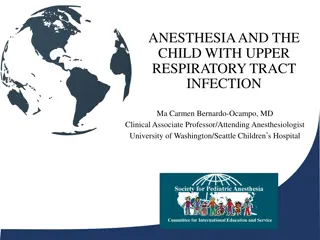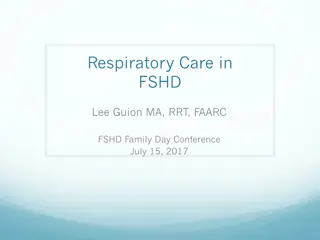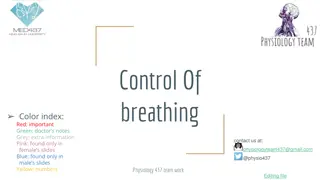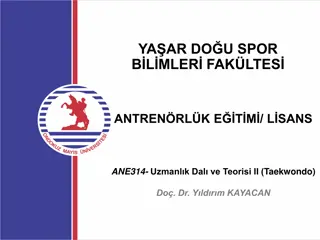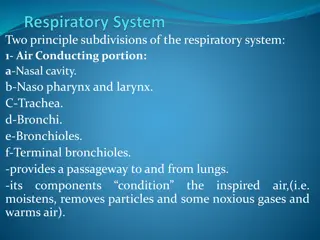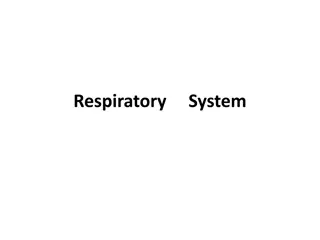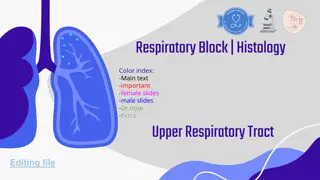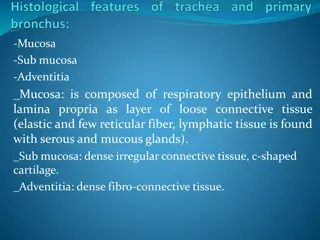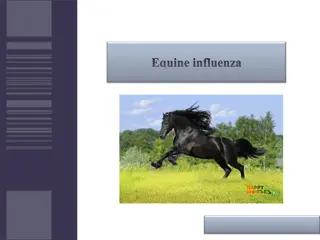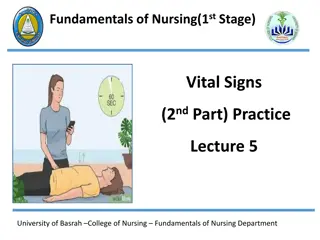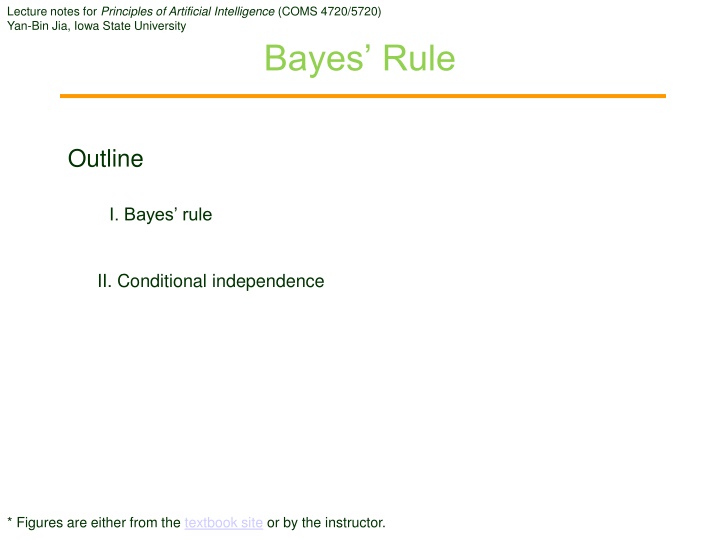
Introduction to Respiratory Block: Major Learning Objectives
The Respiratory Module is a 4-week program aimed at understanding the normal structure and function of the respiratory system, describing common respiratory disorders, correlating clinical features with disease pathophysiology, planning investigations for diagnosis, and detailing principles of treatment. The course covers asthma, allergies, COPD, and pulmonary tuberculosis, among other topics. Emphasis is placed on diagnosing, managing, and addressing respiratory disorders effectively.
Download Presentation

Please find below an Image/Link to download the presentation.
The content on the website is provided AS IS for your information and personal use only. It may not be sold, licensed, or shared on other websites without obtaining consent from the author. If you encounter any issues during the download, it is possible that the publisher has removed the file from their server.
You are allowed to download the files provided on this website for personal or commercial use, subject to the condition that they are used lawfully. All files are the property of their respective owners.
The content on the website is provided AS IS for your information and personal use only. It may not be sold, licensed, or shared on other websites without obtaining consent from the author.
E N D
Presentation Transcript
Lecture notes for Principles of Artificial Intelligence (COMS 4720/5720) Yan-Bin Jia, Iowa State University Bayes Rule Outline I. Bayes rule II. Conditional independence * Figures are either from the textbook site or by the instructor.
I. Bayes Rule (product rule) ? ? ? = ? ? ?)?(?)= ? ? ?)?(?) ? ? ?)? ? =? ? ?)?(?) Portion caused by ?: ? ? ?)?(?) ? ? ?) =? ? ?)? ? (Bayes rule) ?(?) Probability of ?: ?(?) Probability of ? given ? It tells us how often ? happens given that ? happens, when we know: how often ? happens given that ? happens, and how likely ? is on its own, and how likely ? is on its own.
Bayes Rule for Multivalued Variables ? ? ?) =? ? ?)? ? ?(?) The above is a set of equations, each for a pair of possible values of ? and ?. A more generalized version conditionalized on some evidence ?: ? ? ?,?) =? ? ?,?)? ? | ? =? ?,? ?) ? ? ?) ? ? ?)
Applying Bayes Rule Perceive as the evidence the effect of some unknown cause. Determine the cause. diagnostic relationship causal relationship ? causeeffect) =? effectcause)? cause ?(effect) Probabilistic information is often available in the form ?(effect|cause) not ?(cause|effect). The doctor knows ?(symptoms|disease) and wants to derive a diagnosis ?(disease|symptoms).
Example 1 The doctor knows: The disease meningitis causes a patient to have a stiff neck 70% of time. The prior probability that any patient has meningitis is 1/50,000. The prior probability that any patient has a stiff neck is 1/100. Portion due to meningitis ?: The patient has a stiff neck. ?: The patient has meningitis. 0.01 0.000014 0 ? ? ?) = 0.7 ?(?) = 1/50000 Probability of stiff neck ?(?) = 0.01 ? ? ?) =? ? ?)?(?) =0.7 1/50000 0.01 = 0.0014 ?(?) Identify the probability of meningitis given a stiff neck with the disease portion of contribution to the symptom.
Prior Probability of the Evidence ? ? ?) =? ? ?)?(?) ? ?(?) We obtain ?(?) from computing ? ? ?) and ? ? ?): ? ? ?) ? ? = ? ? ?) ? ? ? ?,? = ? ? ?) ? ? = ? ? ?) ? ? ? ? ?) ? ? + ? ? ?) ? ? = ? ? ?) ? ? + ? ? ?) ? ? ? ? ?) + ? ? ?) = 1 ? ? =? ? ?) ? ? + ? ? ?) ? ?
Example 2 Beliefs If a patient has lung cancer, there is a 60% chance that an X-ray test will come back positive; and a 40% chance negative. If a patient does not have lung cancer, there is 2% percent chance that an X-ray test will come back positive ; and a 98% percent chance negative. Population cancer rate is 1/1000. Observation X-ray test came back positive. Inference task What is the chance that the patient has lung cancer? ?: The patient has cancer. ?: The patient s X-ray test comes back positive. ? ? ?) =? ? ?)?(?) ? ? ?)?(?) = ?(?) ? ? ?)? ? + ? ? | ? ?( ?) 0.6 0.001 = 0.6 0.001 + 0.02 0.999 0.02915
Bayes Rule (General Form) Apply normalization to Bayes rule when ?(?) is unknown: ? ? ?) = ? ? ? ?)? ? ,? ? ?)?( ?) 1 1 random variable with two values ? and ?. ? = ?(?)= ? ? ?) ? ? + ? ? ?) ? ? ? ? = 1 ?(?) ? ? ?) needs to be estimated instead of ?(?). Sometimes this is easier, sometimes harder. ? ? ?) = ? ? ? ?)? ? normalization constant to make the entries in ? ? ?) sum to 1.
II. Combining Evidence What happens when we have two or more pieces of evidences? Suppose we know the full joint distribution. ? Cavitytoothache catch) = ? 0.108,0.016 0.871,0.129 1 ?= ? toothache catch = 0.108 + 0.016 = 0.124 Does not scale up to a large number of evidence variables.
Exponential Growth Apply Bayes rule: ? Cavitytoothache catch) = ??(toothache catchCavity ?(Cavity) namely, ? cavitytoothache catch),? cavitytoothache catch) = ? ? toothache catchcavity),? toothache catch cavity) // elementwise product ?(cavity),?( cavity) ? (Boolean) evidence variables: Toothache, Catch, X-rays, Diet, 2? possible combinations of observed values ?(toothache catchCavity Toothache are needed!
Conditional Independence Toothache and Catch are independent given the presence or absence of a cavity. Each is directly caused by the cavity. Neither has a direct effect on the other. Toothache depends on the state of the nerves in the tooth. The probe s accuracy depends on the dentist s skill irrelevant to the toothache. Conditional independence of toothache and catch given Cavity: ? toothache catchCavity) = ?(toothacheCavity?(catchCavity Bayes rule: ? Cavitytoothache catch) = ? ?(toothache catchCavity ?(Cavity) ? Cavitytoothache catch) = ??(toothacheCavity?(catchCavity ?(Cavity)
Definition of Conditional Independence Conditional independence of two variables ? and ? given a third variable ?: ? ?,? ?) = ? ? ?) ? ? ?) ? ? ? Toothache,CatchCavity) = ?(ToothacheCavity?(CatchCavity // asserts independence for all possible combinations of values of // Toothache and Catch. Equivalent forms: and ? ? ?,?) = ? ? ?) ? ? ?,?) = ? ? ?) Decomposition into smaller conditional assertions.
Decomposition of Joint Distribution ?(Toothache,Catch, Cavity) = ?(Toothache,CatchCavity?(Cavity) = ?(ToothacheCavity?(CatchCavity ?(Cavity) 3 tables of dimensions 2 2,2 2, and 2 1 with a total of 2 + 2 + 1 = 5 independent numbers (which appear in the first row of every table). With ? symptoms, the size grows as ?(?) instead of ? 2?. Conditional independence assertions allow probabilistic systems to scale up. They are more commonly available than absolute independence assertions. Decomposition of large probabilistic domains through conditional independence is one of the most important recent developments in AI.


